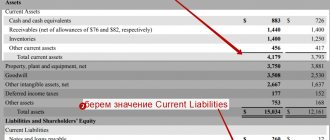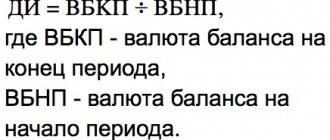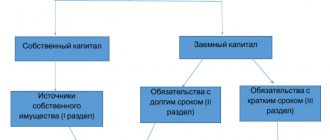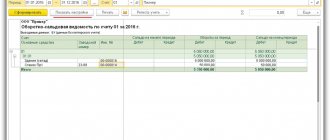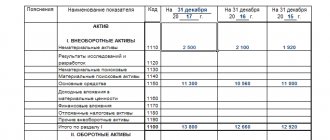Categories
There is a general methodology for calculating the standard of own working capital for work in progress. Depending on the nature of the activity of an industrial enterprise, there are features of its application. For example, for an enterprise with a seasonal nature of work, it is necessary to calculate the monthly working capital standards for work in progress.
To calculate the standard of own working capital for work in progress, it is necessary to determine the standard of working capital for work in progress and the volume of one-day costs for production.
The rate of working capital is determined based on the duration of the production cycle and the rate of increase in costs.
The production cycle time includes the time spent on:
- direct processing process (technological stock);
- waiting for processed products at workplaces (transport stock);
- the presence of processed products between individual operations and individual workshops due to differences in the rhythms of equipment operation, etc. (working stock);
- the presence of products during mass production in the form of safety stock in case of interruptions (safety stock).
The period during which processed products are in transport, working and safety stocks is the waiting time for products in the production process, as opposed to the time of direct processing .
Let's consider an example of calculating the duration of a production cycle (Table 1).
So, the average duration of the production cycle is 14.08 days (Tav = 0.52 × 16 + 5 × 0.27 + 21 × 0.21).
To determine the rate of working capital for work in progress, in addition to data on the duration of the production cycle, it is necessary to know the degree of readiness of the products. It is reflected by the so-called cost increase coefficient . At enterprises where processing costs are uniform, the cost increase coefficient (Rnar) is determined by the formula:
Rnar = (Ce + 0.5 × Sp) / (Ce + Sp), (1)
where Ce is the costs incurred at a time at the beginning of the production process;
Sp - subsequent costs until the end of production of products.
For example, if the monthly costs according to the plan are 3,200 thousand rubles, including one-time costs of 2,600 thousand rubles, and subsequent costs of 600 thousand rubles, then the cost increase coefficient will be equal to:
(2600 thousand rubles + 0.5 × 600 thousand rubles) / (2600 thousand rubles + 600 thousand rubles) = 0.906.
If costs increase unevenly, then the coefficient Rnar is determined according to the graph of the sequence of increase in costs for the main products. In our example, the rate of working capital for work in progress (NAWP), defined as the product of the average duration of the production cycle in days and the cost increase factor, will be
14.08 days × 0.906 = 12.76 days.
The working capital standard for work in progress is defined as the product of the cost of one-day expenses according to the cost estimate for production and the working capital standard.
If the monthly cost estimate for the plan is 3,200 thousand rubles, then the one-day expense is 106.6 thousand rubles. (3200 thousand rubles / 30). In this case, the standard for work in progress (WIP) will be equal to:
106.6 thousand rubles. × 12.76 days = 1360.22 thousand rubles.
The general formula for calculating the standard of working capital for work in progress (NVWIP) is as follows:
NVNZP = (C × Tav × Rnar) / T, (2)
where C is the cost of production of products for the period being calculated (month, quarter, half-year, etc.);
T - duration of the period in days (month, quarter, half-year, etc.);
Tav — average duration of the production cycle, days.
The working capital standard for work in progress in certain industries can be calculated by other methods, depending on the nature of production. Let's consider this situation. Let's take an enterprise with a pronounced seasonal nature. The main peak of sales and production occurs in May–September. The production plan is presented in table. 2.
As with any manufacturing enterprise, there are limitations on production capacity, in this case on the production of blanks. The maximum possible operating time of equipment at the procurement site is 600 hours.
Accounting for work in progress: examples
Example 1
LLC "Hermes" is engaged in the production of hardware and forms the cost of production at full costs. Let's calculate the amount of work in progress for May 2021 according to accounting data:
Expenses:
- Inventory and materials released into production – 526,300 rubles.
- services of contractors for setting up equipment – 120,000 rubles.
- the wages of workers and AUP were accrued - 200,000 rubles.
- deductions of insurance premiums to funds - 60,000 rubles.
- depreciation of machines per month - 42,000 rubles.
- utility bills - 70,000 rubles.
- general business expenses - 50,000 rubles.
- General production costs – 32,000 rubles.
- the cost price of the produced GP is 856,000 rubles.
At the end of the month, the accountant will issue the following entries:
| Operations | D/t | K/t | Sum |
| Costs taken into account: | |||
| — Inventory and materials transferred to main production | 20 | 10 | 526 300 |
| - salary | 20 | 70 | 200 000 |
| — insurance premiums | 20 | 69 | 60 000 |
| — setup services | 20 | 60 | 120 000 |
| - OS wear and tear | 20 | 02 | 42 000 |
| - payment of utility costs | 20 | 60 | 70 000 |
| - general running costs | 20 | 25 | 50 000 |
| — general production expenses | 20 | 26 | 32 000 |
| GP cost written off | 43 | 20 | 856 000 |
The amount of work in progress as of May 31, 2020 will be 244,300 rubles. (526,300 + 200,000 + 60,000 + 120,000 + 42,000 + 70,000 + 50,000 + 32,000 – 856,000).
Example 2
On the balance sheet of Hermes LLC there is an unfinished building worth 1,200,000 rubles. The company decided to sell the “unfinished project” for 2,000,000 rubles. VAT of 400,000 rubles was charged on the transaction amount. The conclusion of a purchase and sale agreement and the sale of an object are documented by entries in accounting:
| Operations | D/t | K/t | Sum |
| Payment has been received from the buyer | 51 | 62 | 2 400 000 |
| Revenue recognized | 62 | 91/1 | 2 400 000 |
| VAT charged (simultaneously with the sale) | 91/3 | 68 | 400 000 |
| WIP cost written off | 91/2 | 08 | 1 200 000 |
| Financial result from the sale of “unfinished construction” (2,400,000 – 400,000 – 1,200,000) | 91 | 99 | 800 000 |
Results
The standard for working capital in inventories, as well as the standard for working capital in work in progress, are among the key criteria for assessing the effectiveness of an enterprise’s business model. The lower they are, the more efficient production can be considered.
You can get acquainted with other significant economic indicators that characterize the efficiency of an enterprise in the articles:
- “Determining return on equity (formula)”;
- "Ratio of accounts receivable and accounts payable."
You can find more complete information on the topic in ConsultantPlus. Free trial access to the system for 2 days.
Sale of unfinished construction: accounting entries
If you have unfinished property on your balance sheet and you plan to sell it, you will need to charge VAT on the amount of the intended sale. The moment of determining the base for tax calculation is equal to the date of state registration of the transaction.
The accountant will make the following entries in accounting:
- Dt 62 Kt 91 – at the time of recognition of sales revenue;
- Dt 91 Kt 68 – VAT is charged simultaneously with the sale of the asset;
- Dt 91 Kt 08 – construction is taken into account for the cost of unfinished construction;
- Dt 51 Kt 62 – payment by the buyer is taken into account.
Working capital standard for future expenses
NORbr is determined using the following indicators:
- PSbp (carryover amount of subsequent periods);
- Rb (upcoming, upcoming expenses in the next year according to the enterprise’s scientific and technological progress plan);
- Rbs (upcoming expenses written off to cost next year).
Formula for calculation:
NORbr=PSbp+Rb-Rbs (9)
Alternatively, you can calculate NORbr in one more way:
NORbr=Rnp+Rpg-Rsp (10)
The formula uses abbreviations for the following expenses: Rnp – at the beginning of the period; Rpg - planned for the year, Rsp - which need to be written off in the plan year.
An example of standardization of future expenses
Task 1: calculate the NOBR for expenses for the development of new products:
- Rnp=11,980 thousand RUR rub.;
- Rpg=14,500 thousand growth. rub.;
- RSP = 12,900 thousand rubles. rub.
Calculation: NORbr=Rnp+Rpg–Rsp=11,980 +14,500 – 12,900=13,580 thousand rub. rub.
Task 2: calculate NORBR for the following costs, including rent for warehouses and their repairs:
- Rnp=596 thousand RUR rub.;
- Rpg=620 thousand growth. rub.;
- RSP=600 thousand RUR rub.
Calculation: NORbr=Rnp+Rpg-Rsp=596+620–600=616 thousand rub. rub.
Task 3: Calculate the total NOBR based on the following aggregate data:
- Rnp = 12,576 (11,980+596) thousand rubles. rub.;
- Rpg=15,120 (14,500+620) thousand growth. rub.;
- RSP = 13,500 (12,900+600) thousand rubles. rub.
Calculation: NORbr=Rnp+Rpg–Rsp= 12,576+15,120–13,500=14,196 thousand rub. rub.
Expenses
The size of work in progress is of particular importance; the smaller the work in progress, the better the working capital will work.
At the same time, work in progress must maintain standard settings for such parameters as volume, composition and placement along the entire production line, while maintaining the pace and quality of work of the entire enterprise. We can conclude that an insufficient volume of work in progress can also negatively impact the organization’s activities.
When preparing a report on all types of enterprise expenses, the following classification is used:
- consumption of material resources;
- costs of providing employees with wages;
- depreciation means;
- costs to meet social needs;
- other costs.
However, it is worth understanding that the list of costs is much wider and depends on the nature of the manufacturing industry. The legislation offers a standard nomenclature, which includes the following items:
- own raw materials and materials;
- returnable production waste (deduction line);
- purchased materials, as well as services provided by third parties;
- energy or fuel to support production;
- wages of production workers;
- general production expenses (provision of main and auxiliary production);
- expenses for production preparation, training and technology development;
- general business expenses (management expenses);
- mandatory contributions (including contributions to social funds);
- costs of defective products;
- business expenses;
- other expenses.
Serial production, including work in progress of material products or services, is analyzed in the balance sheet according to the following points:
- Price settings for raw materials, semi-finished products and other materials.
- Planned production cost.
- Amount of consumable raw materials.
If an enterprise is engaged in a single production of a certain type of product, then in the balance sheet the work in progress is taken into account based on the direct costs of the material.
Funds that were spent by the organization during the preparation of reporting, and at the same time relating to future reporting periods, must be entered into a special item by the accounting department. These funds must certainly be written off for the period to which they relate, evenly and in accordance with the procedure established by the enterprise.
Working capital standard for finished product inventories
We are talking about those products that have passed technical control and were delivered to the warehouse, i.e. these are finished products. Made for her. the cycle has ended. The safety standard for a given product is a period that begins with its receipt at the warehouse and ends with the moment of payment. The norm depends on the time of assembly, packaging of these products, markings applied to them, as well as on delivery from the warehouse and a number of other factors.
To calculate the standard value (NORgp) you will need:
- OVsds (average daily output volume);
- Vzp (time to prepare products for shipment, including reception, packaging, shipment, etc.);
- Water (time to complete the required documentation).
Formula for calculation:
NORgp=OVsds(Vzp+Water) (11)
Alternatively, NORgp can be calculated using the formula:
NORgp=OVsds*Nzgp (12)
Abbreviations: Нзгп – stock norm ready. products.
Example of rationing of finished products
Task 1: determine the NORgp of the first product using the following data:
- OVsds = 550 thousand. rub.;
- NZgp = 8 days.
Calculation: NORgp = OVsds * Nzgp = 550 * 8 = 4,400 thousand rubles. rub.
Task 2: determine the NORgp of the second product using the following data:
- OVsds = 430 thousand. rub.;
- NZgp = 6 days.
Calculation: NORgp=OVsds*Nzgp=430*6=2,580 thousand rub. rub.
Task 3: determine the general NORgp based on the data:
- NORgp for the first product = 4,400 thousand rubles. rub.;
- NORgp for the second product: RUR 2,580 thousand. rub.
Calculation: NORgp1+NORgp2=4,400+2,580=6,980 thousand rub. rub.


